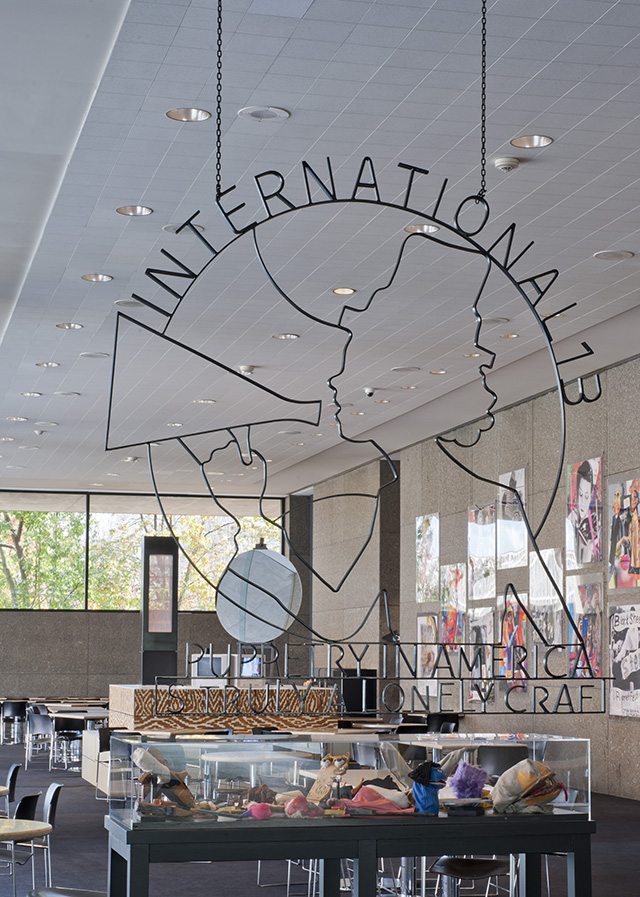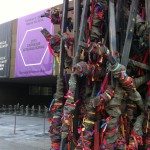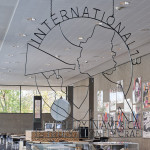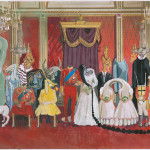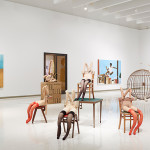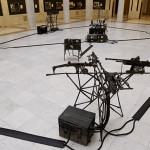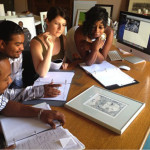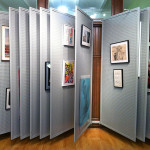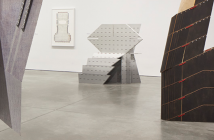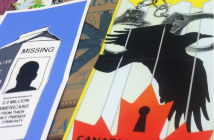Established in 1896, the Carnegie International is the oldest North American survey of contemporary art from around the globe, and the second oldest of its kind in the world, preceded only by the Venice Biennale of 1895. This latest International marks a pivotal moment in the exhibition’s history. Globalization has renewed a conversation around national identity and birthed an art world more saturated than ever with art fairs, festivals, and the pressure to develop a world picture of contemporary art.
"This is an anti-art fair in many ways," explains the International’s co-curator Dan Byers. There are certainly big brand name artists in the show, those who have drawn international attention and whose works have sold for incredible prices. But the show itself is intentionally and inherently very human. Roberta Smith in a New York Times review refers to the International as "a welcome shock to the system of one of the art world’s more entrenched rituals"—festivalism—and GalleristNY deems the show "a quiet triumph." Yet, there is nothing quiet about the International. In an ambitious act of defiance, the three co-curators Daniel Baumann, Dan Byers, and Tina Kukielski abandon the grandeur and excess of the festival. Instead, the curators weave a lean narrative of multiplicity and dissonance that sweeps through the latter half of the 20th century to present day.
Paulina Olowska,
Puppetry in America is Truly a Lonely Craft, 2013.
Wrought iron and enamel paint.
The Henry L. Hillman Fund. Photo: Greenhouse Media
Recently, I had the privilege of sitting down with Dan Byers in the Carnegie Museum’s café, transformed by the puppetry and raw signage of artist Paulina Olowska (b. 1976, Poland), to discuss the research process, probe ethics at the intersection of art, innovation, and commerce, and question the future of art in civic spaces. Appointed the Carnegie’s first Richard Armstrong Curator of Contemporary Art in 2012, Byers brought a certain amicable ease, humility, and a careful optimism—although perhaps mistaken for skepticism at times—to the conversation, providing insight into the raison d’être of not only the International, but of his career in the field.
"Art is not about progress necessarily," Byers muses, "Much of art is about wrong turns, obstacles, complications, and failure." Rather than finding solutions, art uncovers more interesting questions and presents opportunities. It serves as a way to think about the world, to see alternatives, and to explore the human experience. This philosophy is reflected throughout the International. Its artists are introduced as distinct voices that, as noted in the catalogue, "celebrate art as the place to change our thinking… [to]expose us to enigmatic forms, new ways to understand history, and the confusing beauty of the everyday."
Selecting these voices was no easy task for the trio of curators. Baumann, Byers, and Kukielski traveled and conducted their research separately, but came together to attend major shows including the Documenta and Venice Biennale. According to Byers, this process pushed the curators to interpret and defend what they had independently seen to their first audience: each other. The additional step of critical evaluation and contention inserted sharper edges and texture into the International. After all, Byers insists, "Consensus makes for a very boring show."
The final selection of artists and collectives contributed to a body of work that is ripe with perspective and interpretation. The International is immediately open and playful. Yet beyond the accessibility of certain works and themes, upon further reflection, viewers find moments of dissonance that are truly quite dark, critical, and political—without being overly self-important.
Rokni Haerizadeh, Drawing for Reign of Winter, 2012—2013. Animated film. Courtesy of the Artist and Gallery Isabelle van den Eynde.
Highlights include the debut of Rokni Haerizadeh’s (b. 1978, Iran) animation Reign of Winter (2012-13), an interrogation of mass media and examination of an excessive, passive consumer culture in the context of the British royal wedding. Mladen Stilinović (b. 1947, former Yugoslavia, now Serbia) takes a capricious, multimedia approach to what he calls "the language of politics," providing insight to power relations and ways of labor in Eastern Europe versus the West. Dinh Q. Lê (b. 1968, Vietnam) assembles a collection of illustrations made by Vietnamese artist-soldiers on the frontlines of the Vietnam War, accompanied by a documentary film weaving interviews together with animations of these drawings and paintings, literally bringing these stories to life. The works create a complex political narrative, one that is deeply invested in the humanity of its people.
Dinh Q. Lê, Light and Belief: Sketches of Life from the Vietnam War, 2012
100 drawings; pencil, watercolor, ink, and oil on paper. Dimensions variable
Video; color, sound. 35 min. Courtesy of the artist and Shoshana Wayne Gallery, Santa Monica. Commissioned by dOCUMENTA 13, Gene and Brian Sherman
Presentation supported by The George Foundation.
This humanity is both physical and ephemeral. Sarah Lucas (b. 1962, England) captures the male gaze, employing hosiery and other feminine materials to conjure the female body in fiber sculptures, rendering the object body, and conversely the body object. Also exploring the humanity of objects as the containers of human remnants, Tobias Madison (b. 1985, Switzerland) turns his attention to the paper tissues that "hold dirt, snot, sperm, excrements, sweat a bit longer in its material state… temporarily [giving]a hollow body to these voices." Madison’s paper tissue lantern installations adorn the corner stairwells of the International. Finally, Pedro Reyes (b. 1972, Mexico) executes a transformation of weapons—pistols, rifles, knives, and other "agents of death"—into quite literally "instruments of life" including homemade drums, cello, and other experimental music-makers.
Sarah Lucas, 2013 Carnegie International installation view, with works by Henry Taylor in the background. Sender Collection © Sarah Lucas. Courtesy of Sadie Coles HQ, London. Photo: Greenhouse Media
Pedro Reyes, Disarm (mechanized), 2012-2013, recycled metal . Courtesy of the artist and Lisson Gallery, London Photo: Greenhouse Media.
The International, above all, treats its audience with respect. The show is unassuming and unpretentious, but rather allows viewers to go as deep or as surface as they please. The exhibition could be beautiful, or it could be dark—but ultimately it is up to the audience to decide how to interpret the collection. "The artworks and the spaces in the museum are completed by the visitors in a way that people in the museum complicate but also define what the work is," Byers adds. The International entrusts its audience with responsibility and agency.
Byers stresses the International’s role as a public exhibition in a civic center, as opposed to a hip contemporary art space or popular art museum, nearly altogether forgoing its place among a saturated market of sprawling art fairs and festivals. He also emphasizes the curators’ responsibility first and foremost to educate in this civic center. The curators have held the International accountable to informing, exposing, and perhaps even instigating change in the world. The International is particularly grounded in its deep Pittsburgh roots and built upon this foundation.
The "Steel City" flourished at the height of the steel industry in the early 20th century, producing nearly half of the nation’s steel output. Beginning in the 1980s, however, Pittsburgh shifted its focus from primarily steel to healthcare, education, and technology, among others. Braddock, a borough in the Eastern suburbs of Pittsburgh in Allegheny County, was especially hit hard by the collapse of the American steel industry in the 1970s and ’80s. That and the crack cocaine epidemic of the 1980s brought the population of Braddock from over 20,000 at its peak in the 1920s to a mere 2,000 today.
The arts in Braddock have in recent years played an important role in the cultural placemaking of the borough. At the 2013 Creative Time Summit "Art, Place & Dislocation in the 21st Century City," outspoken mayor John Fetterman boasted the public art initiatives and community-based programs Braddock offers its residents and neighbors. Braddock’s own breakout photographer, media artist, and activist LaToya Ruby Frazier has been documenting and presenting her hometown in various narratives of politics and propaganda. Frazier’s work is now exhibited widely, on view currently at the Institute of Contemporary Art in Boston, the Seattle Art Museum, and the Museum of Contemporary Art Chicago. Although Pittsburgh’s steel town glory days have passed, the city is perhaps moving toward a creative renaissance.
"For us, we ended up here because Pittsburgh was the lowest common denominator," screenwriter and advertising creative director Phinehas Hodges explained, "There’s a reason it’s been named the most livable city in the U.S." Costs of living are relatively low in Pittsburgh, and there is enough work to support pockets of young creatives. Hodges co-wrote Blood Brother, a feature-length film produced by Pittsburgh visual effects studio Animal, which brought home the 2013 Sundance Audience and Grand Jury Awards for Best Documentary. While Andy Warhol will always be a staple in Pittsburgh, it is evident that there is a new generation of young artists to watch.
Zoe Strauss, Homestead Portrait Studio, part of the series Homesteading
Courtesy of the artist. Commissioned by Carnegie Museum of Art for the 2013 Carnegie International. Photo: Greenhouse Media
When it comes to festivalism, an easy critique of the Venice Biennale is that for each iteration, the gargantuan exhibition essentially drops in and takes over Venice for several months. In contrast, the Carnegie curators built the International from the ground up, highlighting and supporting talent in the local community. Among its 35 participants, photographer Zoe Strauss (b. 1970, Philadelphia, Pennsylvania) and art collective Transformazium (founded 2007, North Braddock, Pennsylvania) are the International’s native inspiration. Krauss focuses her lens on the severely disadvantaged residents of Homestead, Pennsylvania, which in its glory days was the site of Andrew Carnegie’s flagship plant, Homestead Steel Works. Transformazium has partnered with the Braddock Carnegie Library to create the Art Lending Collection, a community art experience in which anyone holding an Allegheny County library card may rent artworks for three weeks at a time with option for renewal. The work in the Art Lending Collection includes at least one donation from each artist in the International, as well as donations from local artists.
Venturing out to the Braddock Library on Byers’ recommendation, I was shown a different side of the International and afforded an outsider’s experience that could not be replicated within the confines of the museum. A forty-minute bus ride from the Carnegie Museum into the heart of Braddock brought me over the same desolate routes and into the Rust Belt decay I had glimpsed in films such as Scott Cooper’s latest Out of the Furnace (2013). I felt the discomfort of the spectacle as I faced the realities of poverty—empty streets, vacant lots, tired scowls—on such a peripheral level, and only in the context of a visit to the Art Lending Collection. I could only imagine the sharp and awkward contrasts between the art world and the Braddock community as outsiders began to trickle in on account of the International.
Through conversations with library employees, thrilled to have a visitor it seemed, I learned in its first month the Art Lending Collection shared 96 artworks with members of the Allegheny community and trained three Braddock residents to be its art handlers. One of these local artist-facilitators, Deavron Dailey, was proud to tell me he would be participating in a reading of texts by American photographer Joel Sternfeld, to be hosted in artist Wade Guyton’s exhibition space at the Carnegie International. In the not-too-distant future, Transformazium hopes to turn the library space into an art center, complete with screen-printing and ceramics studios and various art lesson offerings. I expect, however, it will take much more than the presence of the International to bridge barriers between visitors coming from a point of privilege and the local Braddock community.
Art Lending Collection facilitators at the Braddock Carnegie Library, 2013
© Carnegie Museum of Art
Art Lending Collection display at the Braddock Carnegie Library, 2013. Photographer: Angelina Y. Zhou
2013 marks an important moment in the exhibition’s history: the International must reclaim its relevance in the world and go even further to reestablish itself as a trusted, prestigious, and differentiated brand in contemporary art circles. According to Byers, people may never visit the Carnegie Museum of Art, but their awareness of the brand is crucial to the International continuing to have relevance. The International’s importance must continuously be defended and demonstrated to the art audience as well as the artists who may potentially be invited to participate. Longevity of the exhibition cannot be its only crutch.
Very few international exhibitions take place in a civic space, which gives the Carnegie International a unique opportunity to have a different life and a different conversation with a much broader audience. The curators understand this conversation begins before and extends far beyond the time a visitor sets foot inside the space. So, the curatorial team joined forces with the education and marketing teams to execute a thoughtful and robust promotion plan in the local and international art communities.
The strategy included a partnership with Contemporary Art Daily, an online journal that publishes images to publicize international exhibitions, and an extensive communications campaign on social media including Facebook, Twitter, Instagram, Tumblr, and the curators’ blog, among others. Byers laments, in the desire to communicate and share, what is often overlooked is the production and collection of shareable content. So, the Carnegie team has deliberately turned to social channels to gather content and engage the audience. From the 3,200+ Instagram photos to the designated #CMOA, #CarnegieMuseum, and #CI13 hashtags and 13,000+ "likes" to the Facebook page, it is clear that this communications strategy is working.
What truly struck a chord for me during this visit was the agility of the curators, and particularly Byers, in considering the International in a context broader than the art world. Along the more tangential lines of our conversation, Byers touched upon crowdfunding (the shift in participation that renders everyone a "patron"), the technology industry (the money is there, but the industry does not tend to be very philanthropic towards the arts), and concepts of design thinking and innovation (and the pressure it puts upon art to be progressive and productive), to name a few. This expanded understanding of art and art systems allows the curators to take a 360-degree view of the art world, critically examining art’s roles and responsibilities in society, and holding art accountable for both its abilities and shortcomings.
Art today is arguably more complex than ever. We are caught between the individual and the mass produced, struggling with a certain cynicism toward major corporations and powerhouses, while taking an interest in the local and the communal. Art, at times, is expected to be extroverted and productive. Yet we still find tremendous value in work that is introspective and exploratory. In a world that teeters on delicate tensions, we rely on context and perspective to stay grounded. The 2013 Carnegie International succeeds in delivering both to the audience.
Moving forward, the International and its trio of curators challenge the audience to consider: how will shifting values, cultures, and technologies affect our production and consumption of art? How will art effect change beyond the object, and out into the world of lived human experience? No matter what the next few years may bring, the Carnegie International is situated such that it is ready not only to adapt and react, but to contribute to and effect these changes in the new era of art and festivalism to come. The future is here, and rather than bracing for change, the International embraces it.

